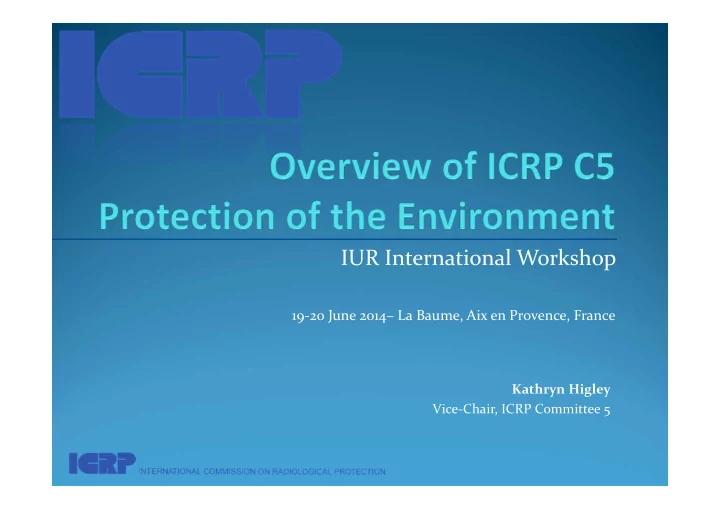

IUR International Workshop 19-20 June 2014– La Baume, Aix en Provence, France Kathryn Higley Vice-Chair, ICRP Committee 5
ICRP is an independent, international organization that advances for the public benefit the science of radiological protection, in particular by providing recommendations and guidance on all aspects of protection against ionizing radiation. ICRP is a Registered Charity (a not-for-profit organisation) in the United Kingdom, and has a Scientific Secretariat in Ottawa, Canada. ICRP is comprised of a Main Commission, a Scientific Secretariat, five standing Committees (on Effects, Doses, Medicine, Application, and the Environment), and a series of Task Groups and Working Parties. 2
Scientific ICRP Main Commission Secretariat Committee 1 Committee 2 Committee 3 Committee 4 Committee 5 Effects Doses Medicine Application Environment Task Groups Task Groups Task Groups Task Groups Task Groups Working Task Groups Parties 3
Main Commission (MC) and Scientific Secretariat direct, organize, and oversee ICRP. Main Commission approves all reports for publication. Committees advise MC and direct Task Groups. Task Groups Established to undertake a specific task, such as production of a single ICRP report. Generally comprised of a mixture of Committee members and other experts in the field. Working Parties Normally formed of Committee members to explore particular issues, May become Task Groups if work is to result in an ICRP publication. 4
Carl-Magnus Larsson, Australia, Chair Kathryn A. Higley, USA, Vice-Chair Almudena Real, Spain, Secretary David Copplestone, UK Jacqueline Garnier-Laplace, France Jianguo Li, China Kazuo Sakai, Japan Per Strand, Norway Alexander Ulanovsky, Germany Jordi Vives I Batlle, Belgium 5
“C5 is concerned with radiological protection of the environment. It will aim to ensure that the development and application of approaches to environmental protection are compatible with those for radiological protection of man, and with those for protection of the environment from other hazards” 6
Planned, emergency, and existing exposure situations Environmental radionuclide concentrations Reference Male & Female, Reference Animals and and Reference Person Plants Dose limits, constraints and Derived Consideration Reference reference levels Levels Decision-making regarding public health and environmental protection for the same environmental exposure situation by way of representative individuals and representative organisms
Review of ethics and principles, recommending that the System for Environmental Protection should focus on biota; consider adequate protection on the basis of understanding of effects; identify reference animals and plants (RAPs); and let the RAPs guide the derivation of exposure scenarios (CFs and DCFs) effects data dose rates benchmarks
(30) ….aim is…preventing and reducing the frequency of deleterious radiation effects to a level where they would have negligible impact on the maintenance of biological diversity , the conservation of species , or the health and status of natural habitats , communities and ecosystems . (366) .....Reference Animals and Plants.......
WILDLIFE GROUP RAP Large terrestrial mammals Deer Small terrestrial mammals Rat Aquatic birds Duck Amphibians Frog Freshwater pelagic fish Trout Marine fish Flatfish Terrestrial insects Bee Marine crustaceans Crab Terrestrial annelids Earthworm Large terrestrial plants Pine tree Small terrestrial plants Wild grass Seaweeds Brown seaweed
ICRP 108 reviews biological characteristics Occurrence Taxonomy Life cycle and life span Reproductive strategy Physiology Ecology .....other factors.....
DCCs for simple geometries Trunk and branch 12
1000 100 mGy/d 10 Invertebrate benchmark Bee Crab Earthworm Plant benchmark 1 Frog Trout Flatfish Grass Seaweed Generic benchmark 0,1 Vertebrate benchmark Deer Rat Duck Pine tree Background level 0,01 0,001 Benchmarks from other studies/systems
Concentration Ratios for 39 elements and 12 RAPs with associated statistics; based on existing field and laboratory data; using new methodology to derive data (‘surrogate data’) where such are missing; taking in to account life cycle stages and habitats, when possible; and discussing the robustness of the data 14
Application in planned exposure situations 15
Application in existing exposure situations 16
Application in emergency exposure situations 17
Decision Broader P108 context P114 Application RP and EP P124 C5 DCRL RAP Dose/Effect/Response Outside of scope Dose rate Source term RAP Transfer RAP DCC Dispersion CR Organism biology and ecology
A robust system has evolved that is compatible with the RP system for man and the EP system developed for other hazards Considering the environment in its own right is appropriate and facilitates communication Simple to apply using default RAPs databases – but can also cope with complex exposure situations Priority during this term to Consolidation Broadening the scientific basis Improving applicability 19
www.icrp.org
Recommend
More recommend